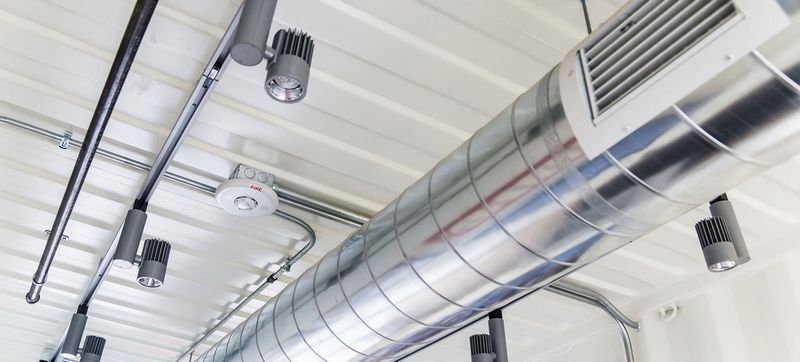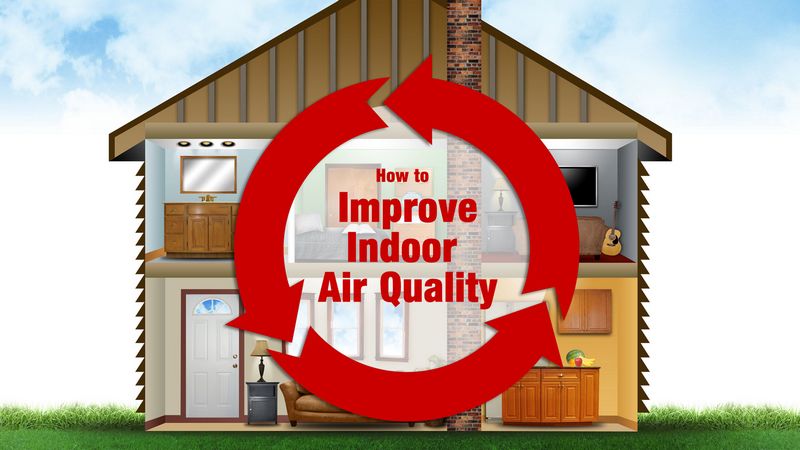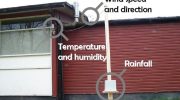
Indoor Air Quality
Indoor air quality is an important aspect of our overall health and well-being. With increasing pollution levels outside, it is essential to create a safe and healthy environment inside our homes. Poor indoor air quality can lead to various respiratory issues and even long-term health problems. To ensure the best possible indoor air quality, it is important to take certain measures to reduce pollutants and toxins.
One of the key factors in maintaining good indoor air quality is controlling the level of humidity. High humidity can promote the growth of mold and mildew, which can release harmful spores into the air. Using dehumidifiers and properly ventilating areas prone to moisture can help reduce humidity levels and prevent the growth of these contaminants.
Airborne contaminants such as dust, pet dander, and pollen can also contribute to poor indoor air quality. Regular cleaning and vacuuming can help reduce these allergens. Additionally, using air purifiers and filters can help capture and remove these particles from the air, ensuring cleaner and healthier air to breathe.
Ventilation is another crucial aspect of improving indoor air quality. It is important to properly ventilate our homes to allow fresh air to circulate and remove stagnant and potentially toxic air. Opening windows and using exhaust fans in bathrooms and kitchens are simple ways to improve ventilation. Installing air exchangers or mechanical ventilation systems can also help in maintaining a constant flow of fresh air.
Regular Cleaning Routine
To improve indoor air quality, it is essential to establish a regular cleaning routine. Dust, dander, and other allergens can accumulate in indoor spaces, leading to poor air quality. By implementing a consistent cleaning schedule, you can effectively reduce the presence of pollutants in your home or office.
- Ventilation: Before beginning your cleaning routine, open windows and make sure your space is properly ventilated. This will help in reducing the concentration of indoor air pollutants.
- Dust Removal: Dust surfaces such as furniture, shelves, and electronic devices regularly using a microfiber cloth. Dusting helps to eliminate allergens and prevents them from circulating in the air.
- Vacuuming: Vacuum carpets, rugs, and upholstery at least once a week. Use a vacuum cleaner with a high-efficiency particulate air (HEPA) filter as it can trap small particles and allergens effectively.
- Mopping: Regularly mop hard floors using a damp mop or a floor cleaner. This helps in removing dirt, dust, and other contaminants that have settled on the floor.
- Pet Care: If you have pets, ensure that you regularly groom them and keep their living areas clean. This will help in reducing pet dander and other allergens that can contribute to poor air quality.
- Bedding and Upholstery: Wash bedding, curtains, and upholstery regularly to remove dust mites, pollen, and other allergens. Use hot water and a fragrance-free detergent to effectively eliminate these pollutants.
- Reduce Clutter: Cluttered spaces make cleaning difficult and create hiding spots for dust and allergens. Keep your indoor environment organized and clutter-free to promote air circulation and facilitate thorough cleaning.
By following a regular cleaning routine, you can significantly improve indoor air quality by removing allergens, dust, and other contaminants. This will create a healthier and safer environment, free from toxic substances and high levels of humidity.
Proper Ventilation
Proper ventilation is essential for maintaining good indoor air quality. It helps to remove toxic pollutants, control humidity levels, and reduce the presence of allergens and other contaminants in the air.
Indoor air quality can often be worse than outdoor air quality, as buildings can trap pollutants inside. These pollutants can come from various sources such as cleaning products, furniture, carpets, and building materials. They can lead to health problems and worsen existing respiratory conditions.
Effective ventilation systems help in diluting and removing these pollutants from the indoor air, providing occupants with a healthier environment. There are several methods for improving ventilation:
- Natural Ventilation: Opening windows and doors, and using window vents or trickle vents can allow fresh air to enter and circulate in the space. This method is cost-effective and environmentally friendly.
- Mechanical Ventilation: Installing mechanical ventilation systems, such as exhaust fans or ventilators, can help remove stale air and bring in fresh air. These systems can be controlled and adjusted as per the specific needs of the space.
- Air Purifiers: Using air purifiers with high-efficiency particulate air (HEPA) filters can capture and remove contaminants from the air, improving indoor air quality.
Regular maintenance of ventilation systems is important to ensure their proper functioning. Filters should be cleaned or replaced as per the manufacturer’s instructions to prevent the accumulation of dust and pollutants.
Proper ventilation can significantly improve indoor air quality, reduce the risk of health issues, and create a more comfortable and pleasant living or working environment. It is essential to consider and implement effective ventilation strategies for better air quality indoors.
Use Air Purifiers
Air pollution is a major concern when it comes to the quality of the indoor air we breathe. It can be caused by a variety of factors, including toxic chemicals, allergens, and poor ventilation. One effective way to improve indoor air quality is by using air purifiers.
Air purifiers are devices designed to remove pollutants from the air, such as allergens, dust, and toxic chemicals. They work by pulling in air and passing it through filters that capture and trap these particles. Once the air is purified, it is released back into the room, providing cleaner and healthier air to breathe.
When choosing an air purifier, it’s important to consider the size of the room and the specific pollutants you want to target. Different air purifiers come with different types of filters, such as HEPA filters, carbon filters, or electrostatic filters, which are designed to address specific pollution concerns.
HEPA filters are highly efficient at removing allergens such as pollen, pet dander, and dust mites. They can also trap toxic chemicals and other particles as small as 0.3 microns in size.
Carbon filters are effective at removing odors and trapping volatile organic compounds (VOCs), which can be emitted by household products, paints, and cleaning chemicals.
Electrostatic filters use an electric charge to capture particles and can be particularly effective at removing smoke, fine dust, and pet dander.
It’s also worth considering the noise level and the energy efficiency of the air purifier when making your selection.
To further improve indoor air quality, it’s important to maintain a healthy level of humidity in the room. Dry air can lead to respiratory irritation, while high humidity can promote the growth of mold and mildew. Using a humidifier or a dehumidifier can help maintain an ideal level of humidity.
In conclusion, using air purifiers can be an effective way to improve indoor air quality and reduce exposure to toxic chemicals and allergens. By selecting the right air purifier for your needs and maintaining proper humidity levels, you can create a healthier and more comfortable environment in your home or office.
Avoid Smoking Indoors
Smoking indoors can significantly impact indoor air quality and pose serious health risks. The smoke from cigarettes contains a wide range of harmful substances, including carbon monoxide, formaldehyde, benzene, and other toxic chemicals. When these contaminants are released into the air, they can lower the quality of indoor air and create an unhealthy environment for everyone inside.
Secondhand smoke is especially dangerous, as it can increase the risk of respiratory problems, heart disease, and lung cancer in nonsmokers. Infants and children are particularly vulnerable to the effects of secondhand smoke, as their respiratory systems are still developing.
Avoiding smoking indoors is crucial for maintaining good indoor air quality. If you or anyone in your household smokes, make it a priority to step outside whenever you need to smoke. This simple step can help prevent the circulation of smoke and the accumulation of harmful pollutants inside your home.
Not only will avoiding smoking indoors improve the air quality, but it will also reduce the amount of pollution in your home. Cigarette smoke creates a lingering odor that can be difficult to remove, even with regular ventilation and cleaning. By smoking outdoors, you can prevent these odors from infiltrating your indoor spaces.
In addition to smoke, cigarettes can also release allergens that can worsen allergies and asthma symptoms. These allergens can accumulate on surfaces such as carpets, upholstery, and curtains, posing a continuous risk to health. By smoking outdoors, you can minimize the presence of these allergens and create a healthier indoor environment for yourself and others.
|
To protect the health of yourself and your loved ones, it is important to avoid smoking indoors. By taking this simple step, you can significantly improve the quality of the air in your home and reduce the risk of exposure to toxic substances and allergens associated with cigarette smoke. If you are a smoker, consider quitting or finding alternative outdoor areas to smoke for the benefit of everyone around you.
Control Humidity Levels
One of the key factors that affects indoor air quality is humidity. High humidity levels can promote the growth of mold and mildew, which can release pollutants and allergens into the air. On the other hand, low humidity levels can lead to dryness and discomfort.
To control humidity levels, it’s important to maintain proper ventilation in your indoor spaces. Good ventilation helps to circulate the air and remove contaminants. You can do this by opening windows and doors to let fresh air in, using exhaust fans in kitchens and bathrooms, and installing air purifiers with humidity control capabilities.
In addition to proper ventilation, you can also use dehumidifiers and humidifiers to control humidity levels. Dehumidifiers help to remove excess moisture from the air, while humidifiers add moisture to the air when it’s too dry. It’s important to monitor and adjust humidity levels according to the recommended guidelines, which are generally between 30% to 50%.
|
By controlling humidity levels in your indoor spaces, you can help to reduce the presence of pollutants, allergens, and toxins in the air, and improve the overall indoor air quality.
Eliminate Mold and Mildew
Mold and mildew can contribute to pollution and reduce the indoor air quality of your home or workplace. These contaminants are not only unsightly but can also be highly toxic, causing a variety of health problems. To ensure a healthier indoor environment, it is important to eliminate mold and mildew as much as possible.
- Identify and fix any sources of moisture: Mold and mildew thrive in damp environments, so it is crucial to identify and repair any leaks or sources of excess moisture in your home or workplace. This can include fixing leaking pipes, repairing roof leaks, and investing in a dehumidifier if necessary.
- Keep humidity levels low: Mold and mildew are more likely to grow in areas with high humidity. Use a hygrometer to monitor the humidity levels in your indoor spaces and aim to keep it below 50%. If necessary, use a dehumidifier to reduce humidity levels.
- Regularly clean and dry affected areas: If you notice any mold or mildew growth, it is important to promptly clean and dry the affected areas. Use a mixture of water and mild detergent to scrub the mold and mildew away, and ensure the area is thoroughly dried afterwards to prevent regrowth.
- Use proper ventilation: Proper ventilation is essential in preventing mold and mildew growth. Make sure kitchens, bathrooms, and other areas prone to moisture have proper ventilation systems in place. Additionally, opening windows and using exhaust fans can help improve air circulation and reduce the risk of mold and mildew.
- Monitor indoor air quality: Regularly monitor the indoor air quality of your home or workplace to ensure that mold and mildew are not present. Use air quality monitors or consult with professionals to regularly test for the presence of mold and other indoor air contaminants.
By taking these proactive steps to eliminate mold and mildew, you can drastically improve the indoor air quality of your space, reducing the presence of toxic pollutants and allergens.
Keep Dust Mites at Bay
One of the biggest allergens found in indoor air is dust mites. These microscopic creatures thrive in warm and humid environments. By reducing their presence in your home, you can greatly improve indoor air quality and reduce the risk of allergies and respiratory issues. Here are some tips to keep dust mites at bay:
- Reduce humidity levels: Dust mites thrive in humid conditions, so it’s important to keep the humidity levels in your home at an optimal level. Use a dehumidifier or air conditioner to maintain a humidity level below 50%.
- Improve ventilation: Proper ventilation is key in reducing dust mite populations. Open windows and doors to allow fresh air to circulate throughout your home. You can also use exhaust fans in bathrooms and kitchens to remove excess moisture.
- Regularly clean and vacuum: Dust mites accumulate in carpets, bedding, and upholstery. Regularly clean and vacuum these areas to remove dust and allergens. Wash bedding in hot water once a week to kill dust mites.
- Choose hypoallergenic materials: Opt for hypoallergenic materials when it comes to bedding, curtains, and upholstery. These materials are less likely to harbor dust mites and other allergens.
- Use allergen-proof covers: Encase mattresses, pillows, and cushions with allergen-proof covers. These covers prevent dust mites from entering and colonizing these areas.
By following these tips, you can significantly reduce dust mite populations in your home and improve indoor air quality. Remember to maintain proper humidity levels, improve ventilation, and regularly clean and vacuum to keep allergens and contaminants at bay.
Choose Natural Cleaning Products
Cleaning our homes is essential for maintaining a clean and healthy indoor environment. However, many conventional cleaning products contain chemicals that can negatively impact the air quality in our homes. These chemicals can release volatile organic compounds (VOCs) and other toxic substances into the air, leading to indoor air pollution.
To improve indoor air quality and reduce exposure to harmful pollutants, it is important to choose natural cleaning products. Natural cleaning products are made from plant-based ingredients and do not contain harsh chemicals or synthetic fragrances. They are designed to be safe for both our health and the environment.
When shopping for cleaning products, look for labels that indicate the product is “green,” “eco-friendly,” or “natural.” These labels are often accompanied by certifications from reputable organizations, such as the Environmental Protection Agency (EPA) or the Green Seal. These certifications ensure that the products meet specific standards for safety and environmental sustainability.
Here are some benefits of using natural cleaning products:
- Reduced exposure to toxins: Natural cleaning products do not contain toxic chemicals, which can help reduce the risk of respiratory problems, skin irritation, and other health issues.
- Better air quality: Natural cleaning products do not release VOCs and other harmful pollutants into the air, improving indoor air quality and reducing the risk of indoor air pollution.
- Environmentally friendly: Natural cleaning products are biodegradable and do not contribute to water pollution or harm aquatic life.
- Safe for children and pets: Natural cleaning products are often safer for use around children and pets, as they do not contain harsh chemicals that could be harmful if ingested or touched.
It’s important to note that even natural cleaning products can cause allergic reactions or sensitivities in some individuals. If you or someone in your household has a known sensitivity or allergy to certain ingredients, make sure to carefully read the product labels and choose products that are free from those specific allergens.
In addition to using natural cleaning products, it’s also important to regularly ventilate your home to improve indoor air quality. Opening windows and using fans can help remove stale air and bring in fresh air from outside. Good ventilation helps to reduce the concentration of indoor air pollutants and maintain a healthier indoor environment.
By choosing natural cleaning products, you can contribute to better indoor air quality and create a safer and healthier living environment for you and your family.
Remove Indoor Pests
Indoor pests such as insects and rodents can have a negative impact on indoor air quality. They can contribute to the build-up of dust, dirt, and other contaminants in the air, which can lead to respiratory problems and allergies. It is important to take measures to remove and prevent these pests in order to maintain a healthy indoor environment. Here are some tips to help you deal with indoor pests:

- Seal cracks and openings: Pests can enter your home through small cracks and openings. Inspect your windows, doors, and walls for any gaps or openings, and seal them with caulk or weather stripping to keep pests out.
- Maintain cleanliness: Keeping your home clean and free of food crumbs and spills can help deter pests. Regularly sweep and vacuum your floors, wipe down surfaces, and clean up any food debris.
- Proper food storage: Pests are often attracted to food sources. Store your food in airtight containers, and keep your pantry and cabinets clean and organized.
- Remove standing water: Mosquitoes and other pests are attracted to stagnant water. Make sure to empty any standing water sources such as pet bowls, flower pots, and gutters.
- Use pest repellents: Consider using natural pest repellents such as essential oils or vinegar to deter pests. You can also use traps or baits to catch and remove pests.
- Seek professional help: If you have a persistent pest problem, it may be necessary to seek professional pest control services. They can help identify the source of the infestation and provide effective solutions.
By taking these steps to remove and prevent indoor pests, you can improve the quality of your indoor air and reduce the risk of respiratory issues and allergies caused by pests and their associated contaminants.
Filter Your Air
Pollution and poor indoor air quality can have detrimental effects on your health and well-being. Whether it’s from outdoor pollutants that seep into your home or from contaminants that are produced inside, having clean air to breathe is essential.
Investing in a quality air filtration system can help remove unwanted particles and improve the air quality in your home. These systems work by circulating and filtering the air, trapping and removing harmful pollutants.
There are different types of air filters available, each designed to target specific contaminants. High-efficiency particulate air (HEPA) filters, for example, can capture tiny particles such as dust, smoke, pollen, and pet dander. Activated carbon filters can help eliminate odors and toxic chemicals.
Regularly changing your air filters is crucial to ensure their effectiveness. Clogged filters can restrict airflow and decrease their ability to remove pollutants. Follow the manufacturer’s recommendations for filter replacement, which is typically every three to six months.
In addition to using air filtration systems, you can also improve indoor air quality by improving ventilation. Proper airflow helps dilute indoor pollutants and allows fresh air to enter. Open windows and doors whenever possible, or use exhaust fans in kitchens and bathrooms to remove excess moisture and pollutants.
Controlling humidity levels is also important. High humidity can lead to mold and mildew growth, while low humidity can cause dryness and irritation. Use a humidifier or a dehumidifier to maintain optimal humidity levels, usually between 30% and 50%.
Reducing the presence of toxic chemicals in your home can also contribute to better indoor air quality. Be mindful of the products you use and opt for eco-friendly alternatives whenever possible. Avoid smoking indoors and take precautions when using cleaning products or pesticides.
In conclusion, filtering your air is an effective way to remove pollutants and improve indoor air quality. By investing in a quality air filtration system, maintaining proper ventilation, controlling humidity levels, and reducing the presence of toxic chemicals, you can ensure that the air you breathe is clean and healthy.
Avoid Toxic Chemicals
Toxic chemicals can be a major source of indoor air pollution. Many household products, such as cleaning agents, paints, and solvents, contain harmful chemicals that can negatively impact indoor air quality. These chemicals can be released into the air through evaporation or by being released as volatile organic compounds (VOCs).
When choosing products for your home, opt for those labeled as non-toxic or low in VOCs. Look for products that have been certified by reputable third-party organizations, such as Green Seal or EcoLogo, as being environmentally friendly and safe for indoor use.
Avoid using products with strong fragrances, as these often contain chemicals that can worsen indoor air quality. Instead, opt for fragrance-free or naturally scented alternatives.
Another way to minimize exposure to toxic chemicals is to maintain a proper level of humidity in your home. High humidity can promote the growth of mold and other allergens, whereas low humidity can increase the levels of airborne pollutants. Using a dehumidifier or humidifier can help regulate the humidity levels and improve indoor air quality.
Proper ventilation is also essential for reducing the concentration of contaminants in indoor air. Open windows and doors regularly to allow fresh air to circulate, especially when using products that release VOCs. Installing exhaust fans in bathrooms and kitchens can help remove pollutants that can be generated during activities like cooking and showering.
By avoiding toxic chemicals and implementing these strategies, you can significantly improve the indoor air quality of your home, creating a healthier living environment for you and your family.
Monitor Carbon Monoxide Levels
In order to ensure the best air quality in your indoor space, it is important to monitor carbon monoxide levels. Carbon monoxide is a toxic gas that can be produced by various sources, such as gas stoves, fireplaces, and furnaces. It is odorless and colorless, making it difficult to detect without proper monitoring.
Exposure to high levels of carbon monoxide can cause symptoms such as headaches, dizziness, and nausea. In severe cases, it can even lead to unconsciousness or death. Therefore, it is crucial to have a carbon monoxide detector installed in your home or office.
Carbon monoxide detectors are designed to detect the presence of this gas and alert you with an audible alarm if the levels exceed a certain threshold. It is recommended to place carbon monoxide detectors in multiple locations throughout your indoor space, especially near bedrooms and areas with potential sources of carbon monoxide.
Regularly check and replace the batteries in your carbon monoxide detectors to ensure that they are functioning properly. Additionally, it is important to test the detectors regularly to make sure they are in working order.
If your carbon monoxide detector goes off or you suspect high levels of carbon monoxide in your indoor space, evacuate immediately and contact emergency services. Be aware that increased ventilation is crucial in such situations, so open windows and doors to let fresh air in.
Monitoring carbon monoxide levels is an essential step in maintaining good indoor air quality and protecting yourself and your loved ones from the potential dangers of this toxic gas.
Regularly Change Air Filters
One of the most important ways to improve indoor air quality is to regularly change the air filters in your ventilation system. Indoor air can contain a variety of pollutants, including dust, pollen, pet dander, and mold spores. These contaminants can accumulate in the air filters over time and impact the overall air quality in your home or office.
By regularly changing your air filters, you can help improve the ventilation and reduce the levels of these indoor air pollutants. Dirty, clogged filters can restrict the airflow, making your HVAC system less efficient and potentially increasing energy consumption.
Changing the air filters is particularly important if you or anyone in your household or office suffers from allergies or asthma. Regularly replacing the filters can help remove airborne allergens and irritants, providing a healthier environment for individuals with respiratory conditions.
How often you should change your air filters depends on a variety of factors, including the type of filter, the indoor air quality, and the level of usage. As a general guideline, it is recommended to change standard air filters every 90 days, but you may need to change them more frequently if you have pets, live in a dusty area, or have a higher level of indoor humidity.
Steps to follow when changing air filters:
- Locate the air filter in your HVAC system. It is usually located in the return air duct or near the blower motor.
- Turn off your HVAC system before attempting to change the filter.
- Remove the old filter and dispose of it properly. Check the condition of the filter, and if it appears dirty or clogged, it’s definitely time for a replacement.
- Take note of the filter size and type so that you can purchase the correct replacement.
- Insert the new filter into the filter slot, making sure it is properly aligned and securely in place.
- Turn on your HVAC system and enjoy the benefits of improved indoor air quality.
In summary, regularly changing your air filters is a simple yet effective way to improve indoor air quality. By doing so, you can reduce the level of indoor pollutants, allergens, and toxins, and provide a cleaner, healthier environment for you and your family or colleagues.
Open Windows
One simple and effective way to improve indoor air quality is to open windows regularly. Opening windows allows fresh air to enter the space and helps in removing indoor air pollutants.
Indoor air can contain various pollutants and allergens, such as dust, pet dander, mold spores, and volatile organic compounds (VOCs) from cleaning products or furniture. These contaminants can contribute to poor air quality and negatively impact our health.
By opening windows, you can allow the fresh outdoor air to circulate and replace the stale indoor air. This helps in reducing the concentration of contaminants and improves the overall air quality inside your home or office.
Opening windows also helps in regulating indoor humidity levels. High humidity can promote the growth of mold and mildew, which can release spores that worsen respiratory conditions and allergies. By letting fresh air in, you can reduce excessive humidity and prevent the buildup of allergens.
However, it’s important to consider the outdoor air quality before opening windows, especially if you live in an area with high pollution. Check the air quality index and avoid opening windows when outdoor pollution levels are high, as it can introduce more toxic pollutants into your indoor space.
When opening windows, it’s also important to consider safety and security. Make sure to use window screens to prevent insects or pests from entering your home. Additionally, avoid leaving windows open when you are not present or during extreme weather conditions.
In conclusion, opening windows is a simple and cost-effective way to improve indoor air quality. It allows fresh air to circulate, reduces indoor pollutants, and helps in maintaining optimal humidity levels. Just be mindful of outdoor air quality and take necessary safety precautions.
Reduce Volatile Organic Compounds
Volatile Organic Compounds (VOCs) are harmful contaminants that can negatively affect indoor air quality. These compounds are released from a variety of sources such as paints, cleaning products, furniture, and building materials. Breathing in high levels of VOCs can lead to respiratory issues, headaches, and other health problems.
To reduce VOCs in your indoor air, follow these tips:
- Ventilate your space: Open windows and doors to allow fresh air to circulate. Use fans or air purifiers with HEPA filters to help remove contaminants from the air.
- Choose low-VOC products: Look for paints, cleaning products, and furniture that are labeled as low-VOC or VOC-free. These products have lower levels of harmful chemicals.
- Avoid smoking indoors: Smoking indoors releases a significant amount of VOCs into the air. Create a designated outdoor area for smoking to prevent indoor air pollution.
- Maintain indoor humidity: High humidity levels can promote the release of VOCs. Use dehumidifiers or air conditioners to control indoor humidity and prevent the growth of mold and mildew, which can also release VOCs.
- Regularly clean and dust: Dust and allergens can accumulate on surfaces and contribute to poor indoor air quality. Regularly clean and dust your space using a damp cloth or vacuum cleaner with a HEPA filter.
- Keep indoor plants: Certain indoor plants, such as spider plants and peace lilies, can help improve indoor air quality by absorbing VOCs and other pollutants.
- Avoid strong fragrances: Many fragrances contain VOCs. Opt for fragrance-free products or choose natural alternatives such as essential oils or unscented products.
By implementing these measures, you can significantly reduce the presence of volatile organic compounds in your indoor environment and improve the overall air quality.
Keep Pets Clean
Pets are a beloved addition to many indoor households. However, they can contribute to indoor air pollution by shedding dander, hair, and other allergens. These contaminants can trigger allergies and respiratory problems in susceptible individuals. To maintain a high indoor air quality when having pets, it is essential to keep them clean and groomed regularly.
Grooming pets regularly:
- Grooming your pets regularly helps remove excess hair and dander from their fur, reducing the amount of airborne allergens in your home.
- Brushing your pets outside can help prevent these allergens from spreading throughout your home.
- Providing your pets with a designated sleeping area, such as a pet bed, can help contain their hair and dander.
Washing your pets:
- Regularly bathing your pets can help reduce the amount of allergens they carry and shed.
- Use pet-friendly shampoos and products recommended by your veterinarian to avoid drying out their skin.
- Ensure that you dry your pets thoroughly after bathing to prevent the growth of mold or mildew.
Controlling pet odors:
- Ensure proper ventilation in your home to help dissipate pet odors.
- Regularly cleaning and disinfecting your pet’s living area can help eliminate odors.
- Consider using air purifiers or filters that can effectively remove pet odors from the indoor air.
By keeping your pets clean and well-groomed, you can minimize the amount of indoor air pollutants they contribute, improving the overall air quality in your home and creating a healthier living environment for both you and your pets.
Check for Radon
Radon is a toxic gas that can be found in indoor air. It is formed from the decay of radioactive elements such as uranium and radium, which are found naturally in soil and rocks. High levels of radon in indoor air can pose serious health risks, including an increased risk of lung cancer.
To check for radon in your home, you can use a radon test kit. These kits are easily available and can be purchased online or at local hardware stores. The kits usually consist of a container that holds a small piece of charcoal or other absorbent material. You place the container in a specific location in your home, such as the basement or a ground-level room, and leave it there for a specified period of time, typically a few days to a week.
After the specified time has passed, you seal the container and send it to a laboratory for analysis. The lab will measure the amount of radon that has been absorbed by the charcoal and provide you with a report of the radon levels in your home. If the radon levels are high, you may need to take steps to reduce them.
Reducing radon levels in your home usually involves improving ventilation. Radon enters homes through cracks and gaps in the foundation, floors, and walls. By sealing these openings and improving airflow, you can help prevent radon from accumulating indoors. Other measures, such as installing a radon mitigation system or using specialized ventilation fans, may also be necessary in some cases.
It’s important to keep in mind that radon is just one of many possible air contaminants in indoor spaces. Other factors, such as poor ventilation and high humidity, can also contribute to poor indoor air quality and the presence of other allergens and pollutants. Regularly checking for and addressing these issues can help ensure that the air in your home is clean and healthy to breathe.
Question-answer:
What are some common pollutants found in indoor air?
Some common pollutants found in indoor air include dust, pet dander, pollen, mold spores, volatile organic compounds (VOCs), and tobacco smoke.
What are the health effects of poor indoor air quality?
Poor indoor air quality can cause a range of health effects such as allergies, asthma, respiratory problems, headaches, fatigue, and even long-term chronic conditions.
How can I improve the indoor air quality in my home?
There are several ways to improve indoor air quality in your home. Some tips include keeping the house clean and free of dust, regularly changing air filters, using natural cleaning products, maintaining proper ventilation, and keeping indoor humidity levels in check.
Can plants really help improve indoor air quality?
Yes, plants can help improve indoor air quality as they naturally remove toxins from the air through a process called phytoremediation. Some air-purifying plants include spider plants, snake plants, peace lilies, and aloe vera.
What are some common sources of indoor air pollution?
Common sources of indoor air pollution include cooking and heating appliances, smoking, cleaning products, building materials, furniture, carpets, and even outdoor pollutants that enter the indoor environment.
How can I improve indoor air quality in my home?
There are several ways to improve indoor air quality in your home. First, make sure to clean regularly to remove dust, pet dander, and other particles from surfaces. Use a high-quality air filter in your heating and cooling system to trap pollutants. It’s also important to properly ventilate your home by opening windows or using exhaust fans. Finally, consider purchasing an air purifier to remove harmful pollutants from the air.
What are some common indoor air pollutants?
There are several common indoor air pollutants that can negatively affect air quality. These include dust mites, pet dander, mold, pollen, tobacco smoke, volatile organic compounds (VOCs) from cleaning products and furniture, and radon gas. These pollutants can cause allergies, respiratory issues, and other health problems. It’s important to take steps to reduce or remove these pollutants from your home.







